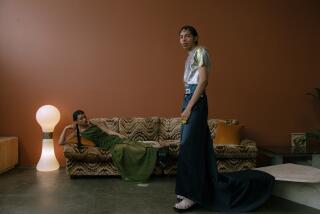Venerable Furniture Store Dusts Off Its Image With Minimalist Line
- Share via
In a dramatic departure from its traditional image of a Colonial living room loaded with sturdy Early American furniture, Ethan Allen has introduced a new line of minimalist furniture. Its accompanying ad campaign features near-surreal photography and the tag line: “Where dream meets reality.”
“I think this is the farthest we have gone,” said Farooq Kathwari, Ethan Allen’s chief executive, in an interview from his Danbury, Conn., headquarters.
The Horizons collection, which features graceful furniture with clean, geometric angles, is also relatively affordable--the slat bed is promoted at $799. The collection combines a contemporary attitude and a blend of cultures in design, said Kathwari. “The inspiration is ‘East meets West.’ Some folks may use the word ‘Zen.’ ”
Other folks may use the words “market-savvy.” Ethan Allen started producing substantial Colonial furniture in the 1930s and popularized a “gallery” look by displaying its furniture in cozy room settings, rather than lined around showroom walls.
Over the years, the company, a household word in furniture, projected “a very, very good Colonial image,” said Kathwari. At a time when American homes were decorated in a uniform style, Early American was a dominant look.
*
But by the 1980s, consumer attitudes were changing. “You first see people’s preference change in clothing--that’s always first,” said Kathwari, who has been carefully following style changes since he joined the company in 1980. “We started seeing stylish clothes in stores like Banana Republic and the Gap. Clothes from Europe were very elegant. People started mixing styles.”
Eventually the eclecticism worked its way into the home. No single style dominated, as the formal living room began to disappear, kitchen walls came down and home offices popped up. When Kathwari became Ethan Allen chairman in 1988, he began making fundamental changes in the operation, including remodeling the company’s 300 stores, which were also Colonial in style.
By the early 1990s, Ethan Allen was reshaping its furniture, adding lighter, neoclassic styles, a children’s line, decorative accessories and more casual contemporary furniture.
“Then we had the challenge to get the message across that we are stylish, and we are affordable,” he said, acknowledging that it hasn’t been easy. “Some people still think of Ethan Allen stores as Early American museums.” But that’s starting to change. “A few years ago, Horizons would be considered a little bit far out, but not today. We’ve not only transformed our image but our financial status--we’ve been very successful.”

